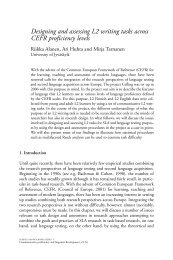BOOK OF ABSTRACTS - EUROSLA
BOOK OF ABSTRACTS - EUROSLA
BOOK OF ABSTRACTS - EUROSLA
Create successful ePaper yourself
Turn your PDF publications into a flip-book with our unique Google optimized e-Paper software.
Child Second Language (L2) Acquisition and Cognitive Development: Is<br />
earlier always better?<br />
Jason Rothman, Drew Long, Anne Lingwall, Tushar Chakravarty,<br />
Jacob Firestine and Becky Halloran<br />
University of Florida<br />
Is there such a thing as “too early” for child L2 acquisition in nonnaturalistic<br />
contexts? Highlighting the fact that children below the age of 6-7<br />
are not fully developed cognitively, Paradis (2010) suggests that older<br />
children might have an advantage for speed of efficient L2 development. In<br />
other words, until cognition is fully developed children might not be ripe for<br />
L2 acquisition, resulting in asymmetric comparative developmental<br />
sequences depending on age of exposure. This is an important empirical<br />
question beyond child L2 studies, because it presents a unique angle to<br />
reveal links between linguistic and cognitive development more generally.<br />
This study compares two sets of child English L2ers in a dual immersion<br />
setting in Cali, Colombia, ages 6-7 and 10-11 at the time of testing, who<br />
have had the same amounts and types of exposure to English (3 years in the<br />
same instructed setting). We report the finding from the first stage of this<br />
larger research project in which the children (n=25 per group) performed a<br />
standardized elicited production picture-story task, a question-answer<br />
comprehension task based on the story and an oral interview. The data show<br />
that the older child L2 group who was 7-8 from the onset of L2 exposure is<br />
much more advanced after 3 years as a group (using MLU measures,<br />
stylistics in story-telling, error rates and overall fluency) compared to the<br />
younger group. We discuss the follow-up empirical experiments currently<br />
underway, examining the acquisition of passive constructions. Paradis’<br />
hypothesis predicts a lag in the younger group for such properties precisely<br />
because they depend on the (cognitively costly) formation of A-chains. The<br />
children will be followed for 5 years moving forward to test whether<br />
Paradis’ contention that the older child advantage fades in time as cognitive<br />
abilities of both groups catch up. We discuss how this second phase will be<br />
accomplished and what it is likely to reveal.<br />
Paradis (2010).The interface between bilingual development and specific<br />
languageimpairment.Plenary address at Generative Approaches to Language<br />
Acquisition North America. University of Toronto<br />
31



